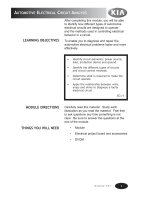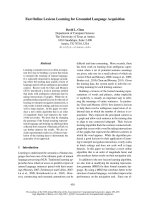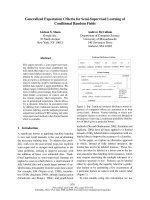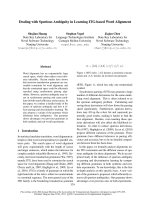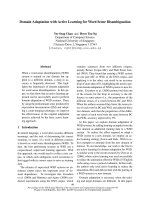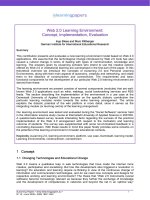Learning Changing Times Changing Tense_3 pdf
Bạn đang xem bản rút gọn của tài liệu. Xem và tải ngay bản đầy đủ của tài liệu tại đây (874.82 KB, 14 trang )
For more material and information, please visit Tai Lieu Du Hoc
at www.tailieuduhoc.org
43
Questions
First student: Make information questions with the questions words below.
Second student: Answer each question with a short answer.
1. Dinosaurs lived on the earth for 135 million years. (How long?)
First student: How long did dinosaurs live on the earth?
Second student: For 135 million years.
2. They appeared 200 million years ago. (When?)
3. They disappeared 65 million years ago. (When?)
4. They ruled the earth for a very long period of time. (How long?)
5. Dinosaurs lived in North America, in Africa, and in Europe. (Where?)
6. Many dinosaurs lived in the water, which helped to hold up their great weight. (Why?)
7. The Stegosaurus developed scales along its back to protect itself. (Why?)
8. The Stegosaurus developed a “second brain” by its back legs to control its leg
movements. (Why?)
9. About 70 million years ago, the Rocky Mountains formed in North America. (When?)
10. Fossils are bones which have become stone. (What?)
Time Markers
were, lived, had, ruled Durative Verbs
appeared disappeared Punctual Verbs
died out
You have learned that the past tense can be used to describe a single point of time in the
past. Punctual verbs in this chapter reading are: appear, disappear, die out, change, and
form. These verbs mark the beginning and the end of the dinosaur period. The word ago is
often used to fix an exact time in the past.
The past tense can also describe a period of time in the past, which began and ended in the
past. Durative verbs which show a period of time are: be, live, have, and rule. Time
markers which show the length of this time period are for (for 135 million years) and from
to (from 200 million years ago to 65 million years ago).
Listen to the sentences below. If the verb describes a point in time, respond with the time
marker “many years ago.” If the verb describes a period of time, respond with the time
marker “for many years.”
1. Dinosaurs ruled the earth.
2. They appeared on the earth.
3. Dinosaurs lived in North America.
4. They disappeared from North America.
5. The land in North America was under a shallow sea.
6. The Stegosaurus developed a “second brain.”
7. Plant eaters and meat eaters lived together.
8. Dinosaurs died out.
9. The Rocky Mountains formed and the weather changed.
10. Dinosaur bones changed to stone.
Contrasting the Present Perfect Tenses with the Past Tense
Both the present perfect tenses and the past tense can describe a period of time. However,
with the present perfect tenses, that period of time continues until the present. With the
past tense, the period of time must both begin and end in the past. The activity is not
happening in the present.
Listen to the following sentences. Tell whether or not the activity is still happening in the
present.
1. Stella has been living in the same house for fifteen years. (She is still living there.)
2. Dinosaurs lived on the earth for 135 million years. (They are no longer living there.)
3. Dinosaurs ruled the earth from 200 million B.C. to 65 million B.C.
For more material and information, please visit Tai Lieu Du Hoc
at www.tailieuduhoc.org
44
4. The police have been controlling our city since last year.
5. North America was under a shallow sea for many years.
6. Our car was under water for two hours.
7. That rescue worker has been under water for two minutes.
8. The weather has been very warm since last week.
9. The weather was very warm for 135 million years.
10. It rained last week from Wednesday to Friday.
Changing Times, Changing Tenses
Change each sentence from the present perfect to the simple past. Change the time marker
as in the example.
1. I've studied English since 1973. (from 1971 to 1977)
I studied English from 1971 to 1977.
2. I've lived in England since 1975. (from 1974 to 1978)
3. I've had a job as a reporter since 1976. (from 1970 to 1975)
4. I've been working in the city since last year, (from 1972 to 1975)
5. The businessman has owned that store since 1940. (from 1940 to 1970)
6. He has controlled all business activities since 1960. (from 1960 to 1965)
7. She's been traveling around the world since last month. (from January to April)
8. She's been a private secretary since 1973. (from 1973 to 1974)
9. He's been driving his car every day since 1960. (from 1960 to 1970)
10. It's been raining since yesterday. (for two days last week)
Pronunciation
After verbs which end in /t/ or /d/, the past tense ending -ed is pronounced like /əd/. An
extra syllable is added to the verb. Pronounce the words below.
acted needed celebrated
sounded visited painted
started decided landed
waited wanted protected
chapter thirteen
DRY LAND FARMING: AN ART AND A SCIENCE
the past tense PAST TENSE OF BE:
I was we were
you were
he, she, it was they were
VERB ( + ed)
AUXILIARY = did (for questions and negatives)
vocabulary:
crop
drought
dust
situation
Western Plains
Dust Bowl
science
art
Reading Selection
Listen to the teacher read the selection. Then repeat as the
teacher reads in phrases.
Before modern farming methods, farmers lost many crops
to dry weather. Sometimes dry periods lasted for many
years. In those days, a long dry period, or drought, often
turned the land to dust. Then winds came along and blew
the good land away. This happened year after year.
For more material and information, please visit Tai Lieu Du Hoc
at www.tailieuduhoc.org
45
Farmers didn't understand how to plant and so they made the situation worse. Each year
they planted the same crops. They never gave the land a rest. The land became poor with
too much use. They always planted in long, straight
rows. They broke the land into fine dust. They never
planted trees to break the strength of the wind.
The worst dry period was the drought of the 1930's.
Good farmland on the Western Plains became a Dust
Source: W. Grant Heilman Wheat Country Bowl.
Farmers
had a very
hard time
until they
started to
use modern farming methods.
Now farmers plant a different crop every year.
Some years they give part of their land a rest.
The land stays healthy and rich. Modern
farmers form rows in curving lines and plant
trees to stop the wind. Modern crops are
much larger and more dependable.
Dry land farming is both a science and an art.
From the air, the farms look like pieces of modern art.
Questions
1. Why did farmers lose so many crops?
2. How did the drought change the land?
3. What did the wind do to the dust?
4. How long did the dry periods last?
5. How did farmers make the situation worse?
6. What happened on the Western Plains in the 1930's?
7. What methods do modern farmers use?
8. What are modern crops like?
Time Markers
Durative Verbs: lasted, had, became, understood
Punctual Verbs: lost, came, happened, planted, gave,
broke, started, formed
The past tense can also be used to describe repeated,
habitual actions for a period in the past. Repeated
activity is usually expressed by punctual verbs. Many of
the time markers are the same as in the present
habitual tense: sometimes, never, always, often, each
year, year after year.
Make sentences in the past tense with the groups of
words below.
1. often / lose / crops
2. drought / usually / turn land to dust
3. happen / year after year
4. always / plant / straight rows
5. never / give land / rest
6. usually / break land / into dust
Source: Departmenl of Agriculture Don Schuhart
For more material and information, please visit Tai Lieu Du Hoc
at www.tailieuduhoc.org
46
7. never / form / curving rows
8. never / plant / trees
Contrasting the Past Tense and the Present Habitual
Listen to the sentences below. Then tell whether the activity still happens, or whether it
doesn't happen any more.
1. Farmers lost many crops before they used modern methods.
(They don't lose many crops any more.)
2. Crops are large and dependable.
(Crops are still large and dependable.)
3. Dry periods last for many years.
4. Droughts often turned the land to dust in those days.
5. Year after year the winds blew the good land away.
6. Farmers use modern methods.
7. Farmers planted the same crops every year.
8. They always planted in long, straight rows.
9. Farmers sometimes give the land a rest.
10. Farmers broke the land into dust.
11. They plant rows of trees to break the wind.
12. Farmers had a lot of trouble with drought.
Changing Times, Changing Tenses
The problem of drought and dry land farming has been solved. Pretend that another
problem—that of litter in modern cities—was solved some years ago. Retell the story in
chapter one, “Litter is a Problem in Our Cities,” using the past tense. Begin this way:
Litter Was a Problem in Our Cities
Before people decided to stop throwing garbage, litter was a big problem in our cities.
Pronunciation
In questions in formal spoken English, there is often a reduction in sound after the auxiliary
verb did. The change in sound may involve the question word, the verb did, and the
following pronoun. Pronounce the sentences below.
1. Did you lose your crops?
2. Did you give the land a rest?
3. Did your land dry out?
4. Didn't you plant trees?
5. Didn't you plant in curving rows?
6. What did the wind do to the dust?
7. When did it blow?
8. Where did it blow?
9. Why did it hurt the crops?
10. How did it change the land?
11. Who did it hurt?
12. How long did it last?
For more material and information, please visit Tai Lieu Du Hoc
at www.tailieuduhoc.org
47
Unit Five: The Past Habitual Tenses
chapter fourteen
TRANSPORTATION USED TO BE MUCH SLOWER THAN IT IS
NOW
the past habitual tense
USED TO + VERB
AUXILIARY = did + use to + VERB,
for questions and negatives
vocabulary:
desert biplane
camel pilot
transportation load
mechanical engine
improvement tank
refrigerator cabin
monoplane jet
Reading Selection
Listen to the teacher read the selection. Then repeat as the teacher reads in phrases.
For many years in the desert,
camels used to be the only form
of transportation. Before the age
of modern trains, camel trains
used to carry all the goods for
trading between Central Africa
and Europe. Traders sometimes
used to put together camel trains
with 10,000 to 15,000 animals.
Each animal often used to carry
as much as 400 pounds and it
could travel twenty miles a day.
This form of transportation used
to be so important that camels
were called the “ships of the
desert.”
Now modern trains travel across the desert in a very short time. One engine can pull as
much weight as 135,000 camels. In addition, trains use special cars for their load.
Refrigerator cars carry food; boxcars carry heavy goods; stock cars carry animals; and tank
cars carry oil.
Air travel has changed, too. The earliest planes
were biplanes, with two sets of wings. The top
speed of this plane was 60 miles per hour. The
pilots used to sit or lie on the wings in the open
air. The plane engines sometimes used to stop in
the middle of a trip. It used to be impossible to
fly in bad weather. In snow or in rain, the wings
frequently used to become icy. Then the plane
might go down.
Mechanical improvements during the first world
war changed airplanes. Monoplanes took the
place of biplanes. Pilots flew inside of covered
cabins. Still, even these planes were small. Only
rich people used to be able to travel in airplanes.
For more material and information, please visit Tai Lieu Du Hoc
at www.tailieuduhoc.org
48
Now modern jets make air travel possible for all people. No place in the world is more than
24
Source: Boeing Airplane Co. hours away by jet. Further improvements have
lowered the cost of flying, and they have made air travel much safer than it used to be. A
modern 707 can carry 170 people and can fly at 600 miles per hour. People never used to
eat, sleep, or watch movies on airplanes. Now these things are a normal part of air travel!
Questions
1. What used to be the only form of transportation in the desert?
2. How many camels did traders use to put together in camel trains?
3. How fast did the camel trains use to move?
4. How much weight did the camels use to carry?
5. What did people use to call the camels?
6. Explain why air travel used to be so dangerous.
7. Did pilots use to travel in bad weather?
8. Who used to travel on airplanes?
9. What did air travel use to cost?
10. Did people use to eat and sleep on planes?
Making Questions with “Used to”
First student: Change each sentence into a question.
Second student: Answer each question with a short answer.
1. Camels used to carry all the goods between Central Africa and Europe.
2. Camel trains used to be very important.
3. Traders didn't use to keep food cold.
4. Planes used to have two sets of wings.
5. Pilots used to sit or lie on the wings.
6. The wings sometimes used to ice up in bad weather.
7. Poor people never used to ride in airplanes.
8. Air travel used to be more dangerous.
9. Air travel used to be more expensive.
10. Airplanes used to be much smaller.
Time Markers
used to be
used to be able to
used to carry
used to travel
used to fly
In chapters twelve and thirteen, you learned that the past tense could be used to describe a
period of time in the past. Another verb tense which is used for this time picture is the past
habitual tense with “used to.” The past habitual can describe a state or an activity which
lasted for a period of time; it can also describe repeated, habitual actions for a period of
time in the past. The adverbs of frequency are often used with this tense.
The past habitual resembles the present tense (present habitual) in some ways. It is like a
small section of the present tense, but its time period ends before present time. Statements
with “used to” are no longer true in the present.
Below is a conversation between an old man and a modern traveler. Finish the sentences for
the modern traveler; use the past habitual tense.
1. “I have many camels for desert trade.” (before the days of the modern train)
“I used to have many camels for desert trade before the days of the modern train.”
2. “I always send my goods on camels.” (before the days of the modern train)
3. “I ride my camels every day.” (before I sold them all)
4. “My camels often travel twenty miles a day.” (before they got old)
5. “Camel trains leave every week to cross the desert.” (in the old days)
6. “Camels are very important to trade.” (in the old days)
For more material and information, please visit Tai Lieu Du Hoc
at www.tailieuduhoc.org
49
7. “Airplanes are too dangerous to fly in.” (before modern improvements were made)
8. “I'm afraid of flying.” (before I tried it)
Contrasting Tenses: Listening Discrimination
Used to + Verb
to Be Used to + Verb + ing
Do not confuse these two verb tenses. The second one means to be accustomed to
something. It is followed by a verb + ing. Compare these sentences:
I am used to riding on camels (and I will continue.)
I used to ride on camels (but I don't any more.)
Listen to the sentences below as your teacher reads them. Decide which form is being used.
Respond by saying either “and they will continue” or “but they don't any more.”
1. Camels used to carry heavy weights.
2. Camels are used to carrying heavy weights.
3. Traders are used to putting together camel trains.
4. Traders used to put together camel trains.
5. Pilots are used to sitting on the wings.
6. Pilots used to sit on the wings.
7. Pilots used to fly in dangerous weather.
8. Pilots are used to flying in dangerous weather.
9. Rich people are used to flying in airplanes.
10. Rich people used to have the airplanes for themselves.
Time Lines
Make sentences with the verbs below. Use the tense which is indicated in each time line.
1. 2.
used to travel travel
3. 4.
used to carry carry
5. 6.
has changed used to stop
7. 8.
changed took the place of
9. 10.
have lowered eat, sleep, watch movies
Changing Times, Changing Tenses
Retell the story in chapter thirteen, “Dry Land Farming: An Art and a Science”. Use the past
habitual with “used to” whenever it is possible.
Pronunciation
In normal spoken English, the second vowel in “used to” is reduced to /ə/. Notice also that
the final d in “used” combines with the following t, so there is actually no difference in
sound between the phrases “used to” and “use to.”
Pronounce the sentences below.
1. Camel trains used to be very important.
2. Did camel trains use to be very important?
For more material and information, please visit Tai Lieu Du Hoc
at www.tailieuduhoc.org
50
3. Planes used to have two wings.
4. Did planes use to have two sets of wings?
5. The wings used to ice up.
6. Did the wings use to ice up?
chapter fifteen THANKSGIVING ON THE FARM
the past habitual tense with WOULD
WOULD + VERB
vocabulary:
relative twin
extra onion
stove roast
turkey dozen
stuff pie
Reading Selection
Listen to the teacher read the selection. Then repeat as the teacher reads in phrases.
I remember our Thanksgivings on the farm. When I was growing up, we lived on a farm
near the town. There were many other relatives who lived near us. Every year they would
all come, from other farms and from the town, to be with us.
We'd work for days to prepare for the holiday. Mother and the girls would clean every part
of the house, and they'd get all the extra rooms ready for the relatives. Then they'd wash
all our best clothes—we called these dresses and suits our “Sunday best.” The men would
cut extra wood for all the cooking, for we had an old wood-burning stove. Father would
always kill the biggest turkey, and then he'd clean the bird. Finally, the whole 1arm\y would
drive into town to buy the food that we couldn't produce on the farm, like coffee and sugar.
On Thanksgiving morning the women would get up early to begin cooking. Mother would
stuff the turkey with bread and onions, and then she'd roast it. Aunt Ellen would make a
dozen pumpkin pies. Aunt Ann would pick autumn flowers from the garden for the center of
the table. She'd also bring in vegetables to eat with the turkey and the pies.
The older children would help set the table while the twin babies played in their high chair.
But I liked to play with the cat, waiting for somebodytogivemepiecesof food. All this time
our old dog would lie under the warm stove, watching the activity.
For more material and information, please visit Tai Lieu Du Hoc
at www.tailieuduhoc.org
51
Source: Artist Doris Lee.
The Art Institute of Chicago
Questions
1. Where did the woman live when she was growing up?
2. Where did her relatives live?
3. Why would her relatives visit at Thanksgiving time?
4. How long would the family work to prepare for the holiday?
5. What would the women do to get ready for Thanksgiving?
6. What would the men do to help?
7. What would the family do all together?
8. What foods would the women cook on Thanksgiving Day?
9. What would the older children do to help?
10. Where would the dog and cat be?
Time Markers
would clean, would wash, would drive, would get up, would roast, would pick
The time picture for this tense is the same as the picture for the past habitual tense with
“used to,” from chapter fourteen. Notice, however, that the verbs in this reading selection
are punctual verbs rather than durative verbs. The phrase “would be” does not mean the
same thing as the phrase “used to be.” Most English speakers understand “would be” as a
future conditional, in future time, rather than as a past habitual.
Common time markers are the adverbs of frequency, as well as combinations with every
For more material and information, please visit Tai Lieu Du Hoc
at www.tailieuduhoc.org
52
(every year, every month, every time, every Thanksgiving Day). In addition, another time
marker is used to set the period in the past: in my youth, when I was young, in the old
days, before modern times.
Listen to each sentence as your teacher reads it. Then use a past time expression and
repeat the sentence in the past habitual tense with would.
1. Our relatives visit every year at Thanksgiving time. (In my youth)
In my youth, our relatives would visit every year at Thanksgiving time.
2. They come every year to be with us. (Formerly)
3. We usually work for days to prepare for the holiday. (When I was young)
4. Mother and the girls always clean every part of the house. (In those days)
5. We wash our best clothes every week. (In the old days)
6. The men cut wood every day for cooking. (In my youth)
7. The family shops in town every week. (When I was young)
8. The women always get up early to cook. (In those days)
9. Aunt Ellen sometimes makes fruit pies, and sometimes she makes pumpkin pies. (When I
was young)
10. Aunt Ann often picks flowers from the garden. (Jn the old days)
11. The older children help set the table for every meal. (Formerly)
12. Our old dog often watches from under the stove. (In those days)
Changing Times, Changing Tenses
Retell the story in chapter fourteen, “Transportation Used to Be Much Slower,” using would
whenever it is possible. Do not substitute “would be” for “used to be.”
Retell the story in this chapter, using used to. It will be possible to substitute used to for
any phrase with would.
Pronunciation
In normal spoken English, the pronouns and the word not contract with the auxiliary would.
There is no change in the vowel sounds. Pronounce the words below.
I, I'd we, we'd
you, you'd they, they'd
he, he'd
she, she'd would, wouldn't
it, it'd
For more material and information, please visit Tai Lieu Du Hoc
at www.tailieuduhoc.org
53
Unit Six: The Past Continuous Tense
chapter sixteen WHEN THE WALL FELL IN
the past continuous tense
BE + VERB + ing (past)
vocabulary:
dig
accident
crack
refuse
shock
insurance
Reading Selection
Listen to the teacher read the selection. Then
repeat as the teacher reads in phrases.
At six o'clock on April 21,1976, the living room
and front part of this man's house fell in. The
man was having construction workers dig a hole
under the front of the house to add on another
room. The workers weren't there when the
accident happened, so nobody was hurt.
Reporters asked the owner, “What were you
doing when the rooms fell in?”
He answered, “My wife and I were talking to
guests. We were showing them the cracks in the
front room when we heard a loud sound. The
cracks were growing larger, so we called the
construction company. But it was too late. The
construction workers were still driving here when
the rooms fell in.”
The owner's wife was cry ing while the reporters
were talking and refused to have her picture
taken.
“I was standing right here outside the front room
when it fell in,” she said. “It gave me the biggest
shock of my life.”
The owner has told his insurance company about
the accident, and it will pay to rebuild the house.
The construction company says that the house
will soon be as good as new. But many of the
things in the house have been lost forever.
Questions
Answer each question with a complete sentence.
1. When did the rooms fall in?
2. Why wasn't anybody hurt?
3. Who was the owner talking to when the rooms fell in?
4. What was he looking at when he heard the sound?
5. Why did he call the construction company?
6. What were the workers doing when the rooms fell in?
7. What was the owner's wife doing while the reporters were talking?
8. Where was she standing when the front room fell in?
9. Who will rebuild the house?
For more material and information, please visit Tai Lieu Du Hoc
at www.tailieuduhoc.org
54
10. Who will pay for the repairs?
Time Markers
The past continuous tense is rarely used by itself. Rather, it is used to describe what was
taking place when another activity happened in the past. Usually the past continuous is
joined to another clause in the past continuous or in the past tense. The time lines took like
this:
talking talking
crying fell in
She was crying while the reporters They were talking to their guests
were talking. when the rooms fell in.
While she was crying, the reporters While they were talking to their
were talking. guests, the rooms fell in.
The time marker while introduces clauses in the past continuous; when introduces clauses
in the past tense.
Join the following pairs of sentences with the time marker while.
1. The construction workers weren't working.
The owners were talking to their guests.
2. The cracks were growing larger.
The people were looking at them.
3. The workers were driving to the man's house.
The rooms were falling in.
4. The owner's wife was crying.
The reporters were talking to her.
5. The owner was looking at the house.
The reporters were taking his picture.
Join the following pairs of sentences with the time marker when.
1. It was raining. Lightning struck the tree.
2. We were watching TV. Lightning struck.
3. I was sitting by the window. I heard the sound.
4. Nobody was standing near the tree. The lightning hit.
5. We were looking out the window. We saw a flash of light.
Join the following pairs of sentences, first with while and then with when.
1. Mrs. Cady was driving on a mountain road. She lost control of her car.
2. Everybody was wearing seatbelts. A bad accident happened.
3. Mr. Ruter was walking through the water. He fell.
4. He was trying to save the people. He got into trouble himself.
5. Mrs. Cady was watching him. He went under water.
Noncontinuous Verbs
As you have learned, some verbs cannot be used in the continuous tenses. (See chapter six
for a review.) When you are speaking or writing about past time, such verbs will take the
past tense instead of the past continuous.
Listen to the following sentences as your teacher reads them. Change each verb to past
continuous if it is possible. If the verb does not take a continuous tense, simply repeat the
sentence as it is.
1. Construction workers dug a hole yesterday.
2. He wanted another room,
3. They added on another room.
4. They didn't work there last night.
For more material and information, please visit Tai Lieu Du Hoc
at www.tailieuduhoc.org
55
5. My wife talked to our guests.
6. We showed them the cracks in the front room.
7. We heard a loud sound.
8. We called the construction company.
9. It was too late.
10. The rooms fell in.
11. We needed more room.
12. We had more rooms before the accident.
Time Lines
Make sentences with the verbs below. Use the tense which is indicated in each time line.
1. 2.
fell in showing fell in driving
3. 4.
heard growing fell in crying
5. 6.
showing talking
7. 8.
has told have been lost
Changing Times, Changing Tenses
Retell the story in chapter five, “The Kites Are Flying High.” Use the past continuous tense
and answer the question, “What were these people doing on their vacation yesterday?”
For more material and information, please visit Tai Lieu Du Hoc
at www.tailieuduhoc.org
56
Unit Seven The Past Perfect Tenses
chapter seventeen
NOBODY HAD BELIEVED IT WAS POSSIBLE
the past perfect tense
HAD + PAST PARTICIPLE
vocabulary:
iceberg tragedy
lifeboat officer
sink drill
passenger warning
radio speed
survivor direction
Reading Selection
Listen to the teacher read the selection. Then repeat as the teacher reads in phrases.
In 1912, the Titanic hit an iceberg on its first trip across the Atlantic, and it sank four hours
later. At that time, the Titanic was the largest ship that had ever traveled on the sea. It was
carrying 2207 people, but it had taken on enough lifeboats for only 1178 people. When the
passengers tried to leave the ship, only 651 of them were able to get into lifeboats.
The Carpathia was 58 miles away when the Titanic called on its radio for help. It arrived two
hours after the great ship had gone down, and it saved 705 people. Some of the survivors
had been in the icy water for hours when they were saved. Most of the passengers hadn't
lived that long; 1502 people had lost their lives.
Through the whole tragedy, the Cafifornian was only ten miles away. Its officers were close
enough to see the Titanic, but they didn't understand the situation. They never received the
Titanic's call for help, and they didn't come to the rescue until too late.
Why was there such a great loss of life? Why were there so few survivors? Why didn't the
Californian come to help?
First of all, nobody had prepared for such a tragedy. Nobody had believed that the Titanic
